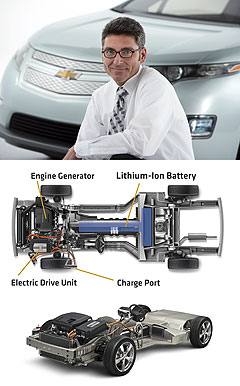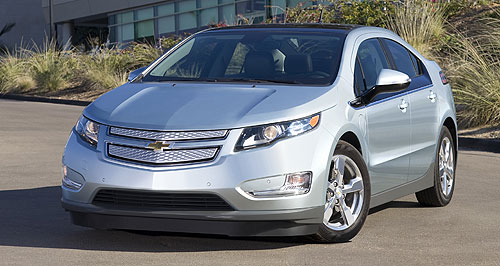News - Chevrolet - VoltGM’s Volt might usher in turbine eraGas goer: GM's Volt might have a turbine generator in its future, if its chief engineer's speculation comes true. GM Volt chief engineer floats idea of gas turbines for future plug-in hybrids25 Jan 2010 THE introduction of range-extending plug-in hybrids such as the Chevrolet Volt could pave the way for gas turbines to finally enter automotive production, according to the Volt’s chief engineer. General Motors’ new green hero uses an on-board generator – powered by a traditional 1.4-litre four-cylinder petrol engine – to produce electricity once its battery has been drained. Unlike a regular petrol-electric hybrid such as the Toyota Prius or Honda Insight, it never drives the wheels, but feeds the battery electricity. The fact that the engine-generator can act independently of the throttle input and does not have to spin up every time the driver wants to accelerate means gas turbines could finally become a viable powertrain option, said Volt chief engineer Andrew Farah. “Turbine engines have been proposed for a number of purposes in the past,” Mr Farah said. “This actually might be the one that gives it a real opportunity in the market place because of that disconnection to the foot, the spin-up time etc, more consistent operation – turbines are very good at that. “This might be the opportunity for a turbine in generation X, whatever that is.”  Left: General Motors Volt vehicle chief engineer Andrew Farah. Below: Volt battery layout. Left: General Motors Volt vehicle chief engineer Andrew Farah. Below: Volt battery layout.The gas turbine, of which the jet engine is a variant, has been touted as a possible vehicle powerplant for much of the 20th century with interest rising dramatically in the 1950s. The now defunct Melbourne-based Cars magazine reported in 1954 that rear-engine gas turbines could be in production by four major automakers by 1955. That did not happen, but Chrysler did produce 50 turbine powered vehicles for customer trials in 1962 which showed the technology was not suitable thanks to noise under acceleration and an average fuel consumption figure of 20.5 litres per 100km. Customers reported that the engines were smooth and quiet once they got going. Mr Farah, who was involved in the GM EV1 electric vehicle (star of the documentary Who Killed the Electric Car?), admitted some GM engineers were already working the next generation of the Volt, although the priority was the first car which will be introduced in the US this November and in Australia in 2012. “We are already looking at what comes after that,” he said. The Volt, which has cost about $US700 million ($A773m) to develop, was first shown as a concept car at the 2007 Detroit motor show and is now in its final prototype stage. It can run for 40 miles (64km) purely on electric power supplied by a T-shaped 300-cell lithium ion battery pack that sits below the front seats and runs down to the rear in a raised section reminiscent of a driveshaft tunnel. GM stresses the range depends on the way it is being driven and the ambient temperature. The maximum output of the electric drive unit is 110kW. The power is fed through two motors that sit inside the transmission, which GM is still reluctant to talk about. One of these motors doubles as a generator. It is likely the transmission is a form of continuously variable automatic. The Volt can be fully charged in three hours to four hours using regular household socket in Australia (240 volt), but takes twice as long using a standard outlet in the US, which uses 110 volts. When the 16kWh battery charge drops to 30 per cent of capacity, the 1.4-litre petrol four-cylinder engine kicks in. GM says it designed the system to make sure the battery was never fully exhausted to maintain power for on-board systems and also avoid battery degradation. “The generator will be operated to keep the battery within a range or a buffer around the 30 per cent mark, just like the thermostat in your house controls the temperature,” Mr Farah said. “There is an upside and downside and we don’t follow it directly.” GM says the engine, which has a different spark fuel and valve program to the regular version, runs in a spectrum between 1000rpm and 4000rpm, generating up to 55kW. The petrol engine produces sufficient power for instant electric drive, but the US version does not recharge the battery fully. Mr Farah said customers would be better off plugging in at home. “The energy generated (at home) could from many different sources, it could come from hydro, coal, nuclear, it could come from wherever it comes from but because it is generated on such a scale it is generally more efficient than running the engine,” he said. An engineer told GoAuto that this method also met certain EPA requirements, which would not apply in other markets where customers would be able to recharge on the run if they wanted. The company is yet to confirm the exact range of the Volt when using draining both the battery and the fuel tank and won’t confirm the size of the fuel tank either. It does advise that the Volt will have a range of at least 300 miles (483km), which is down on the 600 mile (965km) range of the original concept car which had two tanks, but engineers decided the packaging was far from ideal and the range was more than many people required. One problem facing Volt engineers was that it is unclear how often owners will use the petrol engine. If the owner uses electric drive for their daily commute, the engine would sit idle for a long time, as would the fuel. Anyone who has rescued a barn find vehicle can attest that petrol can go bad, and it is worse in cold climates where there are seasonal fuels for different temperatures which can cause problems. GM engineers have built in a system that alerts the driver and suggests running the petrol engine for a short time if it has been left idle for more than a month. The fuel tank is also made of steel, rather than plastic, so that it doesn’t expand and contract with temperature changes which could cause it to flex without any fuel usage. Unlike fully electric vehicles, the Volt can be driven just like any other vehicle and be refilled with petrol. “It’s the only electric vehicle that can be your only vehicle,” Mr Farah said. “I can get the emission-free benefit plus I can also have it as my only car and drive from here to Chicago or wherever it is that I want to go without having to worry where my next plug is.” The Volt is based on the same (Delta) platform as the Cruze small car, but engineers have made a series of revisions to contain the battery back as well other modifications designed to take out weight. These include different grades of steel and composites. There is no word on the official weight, but a senior engineer suggested it would weigh close to 1800kg. It retains the same MacPherson strut front suspension and torsion beam rear axle as the Cruze. Regenerative braking captures some of the energy usually wasted in braking and feeds it back to the battery. Because the engine is not running all the time and is not available to run a hydraulic pump, the Volt uses an electrically-assisted rack and pinion steering system. The battery is 1800mm long and weighs around 200kg, which is quite an improvement on the 2400mm long and 540kg unit developed for GM’s four-seat EV concept car of 1998. The batteries are packaged at GM’s re-developed Brownstown factory in Michigan, packed in a thick plastic casing with liquid cooling. The cells are similar size to paperback novel. The company says while the battery has a peak output of 16kWh, only half of that is used in the interests of durability. GM says the battery will last for 10 years or 150,000 miles (241,000km). GM and LG Chem did extensive testing of the cells to make sure the chemical mixture remained constant over time in varied conditions since 2007. More than 50,000 cells have been tested, 300 packs have been built and they have been subjected to a total of 300,000 real world miles (482,000km). GM has already crashed 20 Volts (intentionally), and the battery packs have been subjected to vibrations, extreme heat, exposed to corrosive materials, set on fire and even have a nail driven through them for good measure. GM global electric systems executive director Mickey Bly said GM locked in the final cell chemistry mixture six months ago after initially testing 60 different types. He said one advantage of working with electric cells is that is scientists come up with a better chemistry mix, the cell can be changed along the way. “We feel we can move very quickly when they change the chemistry,” Mr Bly said. Testing the batteries is not as easy as putting an engine on a dyno and revving it hard for a few hours to test for durability, as is normally the case. Engineers admit that while they have a lot of data, they will have to wait several years to see how the cells hold up in the field. They are, however, confident that the cells will last. At the front, a large four-layer radiator is installed to keep the engine and electronics at the correct temperature, with most of the cool air coming in from the lower grille. GM is not ready to release the drag co-efficient data for the production vehicle, but says the final vehicle is 30 per cent more efficient than the 2007 concept car which had particularly bad drag behind the boot. The Volt seats four people. A centre console above the battery contains two cup-holders and a storage area for the rear occupants. GM has not announced pricing, but executives have hinted the car could cost less than $US40,000 when it goes on sale in November in the US. There is a good chance the vehicle will qualify for a new $US7500 federal government grant for super-low emission vehicles. There is no word on what the Volt might cost when it comes to Australia.  Read more19th of January 2010  First drive: A Volt into the futureGeneral Motors' plug-in Volt quietly goes where no car has been before8th of January 2010  Volt battery pack factory opens in DetroitGM powers up new lithium-ion battery pack plant as next step to Volt production |
Click to shareChevrolet articlesResearch Chevrolet Motor industry news |
















Facebook Twitter Instagram